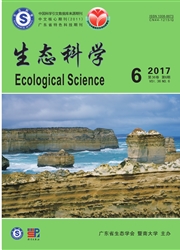

 中文摘要:
中文摘要:
论文对杏林湾表层沉积物重金属、有机碳和硫化物含量进行了检测,对数据作了相关性分析和因子分析,并应用潜在生态危害指数法对重金属的潜在生态风险进行了评价。结果表明:重金属之间有显著的相关性,Cu与Ni、Pb与Ni、Pb与Cr以及Cr与Hg之间的相关系数分别为0.786(P﹤0.05)、0.783(P﹤0.05)、0.937(P﹤0.01)和0.770(P﹤0.05)。重金属与有机碳及硫化物的相关性较差,表明该地区重金属污染来源与硫化物和有机碳并不相同。既有人为输入,又有自然的沉积过程。因子分析进一步解释了该水域重金属污染的主要来源。根据Eir均值大小,Hg的危害风险最大,Cr最小。6种重金属潜在生物毒性风险大小依次为:Hg〉Pb〉Cu〉Cd〉Ni〉Cr。重金属的生态危害程度均较小,尚属轻微生态危害。
 英文摘要:
英文摘要:
Concentration data of heavy metals, organic carbon and sulfides in surface sediments of Xinglin Bay were processed using correlation analysis and factor analysis. Highly positive linear correlations among concentrations of heavy metals were observed: Cu with Ni(r=0.786, P 〈 0.05), Pb with Ni(r=0.783, P 〈 0.05), Pb with Cr(r=0.937, P 〈 0.01) and Cr with Hg(r=0.770, P 〈 0.05). The results showed some lowly positive or negative correlations among heavy metals, organic carbon and sulfides. The results also indicated that heavy metals in sediments of Xinglin Bay had different anthropogenic sources and natural postdepositional processes from organic carbon and sulfides. The main sources of heavy metals in sediments were further explained by factor analysis. The potential ecological toxicity of heavy metals in Xinglin Bay was assessed based on index of potential ecological risk. Concentrations of these heavy metals posed a low potential ecological risk and had a low probability of being associated with adverse biological effects. The sequence of the degree of their potential ecological risks based on the average . i potential ecological risk factors (E r ) was: Hg 〉 Pb 〉 Cu 〉 Cd 〉 Ni 〉 Cr.
 同期刊论文项目
同期刊论文项目
 同项目期刊论文
同项目期刊论文
 期刊信息
期刊信息
